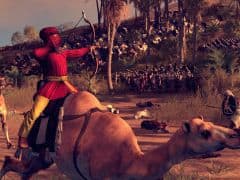You can trust VideoGamer. Our team of gaming experts spend hours testing and reviewing the latest games, to ensure you're reading the most comprehensive guide possible. Rest assured, all imagery and advice is unique and original. Check out how we test and review games here
Are you the sort of strategy player who sees every game of Total War as an opportunity to screw everyone over as much as possible, no matter what the consequence or cost? Then you’re going to love Total War: Rome 2’s newly upgraded political options. The Romans themselves spent nearly as much time stabbing each other in the back as they did their enemies in the front, and so it stands to reason that you should be able to do the same.
Described as more of a mid-to-end-game concern by The Creative Assembly’s Dom Starr, it means that your (no doubt ruthless) rise to power will not go unnoticed or unchecked. “We always felt we needed this concept of infighting” Starr told me. “Rome itself was very torn, people vying for control, several civil wars, and it would be a disservice to the time period to not represent that.”
As you scale the ladder, other factions within your own organisation will make themselves known. Maybe a star general is jockeying for position, or an underling is looking to weaken your power base as he makes his own run for the top.
How you deal with them is up to you. You can ignore the threat, which would be tremendously silly. Or you could do it the old-fashioned (as in, Roman) way: kill or discredit your enemies. Doing so will increase your standing, but Starr told me that you’ll have to be selective about how you wield your power: fail in your mission, and it could backfire and increase your enemy’s resolve. You’ve also got to contend with the fact that, by killing your top men, you’re losing precious allies and, in some ways, weakening yourself.
If it work as promised – and we’ve no reason to doubt that – it will be a great addition to the late game, which in past titles has sometimes devolved into mindless land-grabbing merely for the sake of it. “[It’s about solving] the conflict within; a…crisis that you must solve to assert yourself and go on and achieve your victory conditions” was how Starr described it.
How the backstabbing combines with the other political elements is also intriguing – you can still marry your daughters into other houses, or welcome sons into yours, to maintain and enforce the traditions of your house. If CA can strike the right balance then this could be one of the best additions to the series in years.
Speaking of tradition, there are now systems to ensure that your new recruits are still imbued with the same ethos as their predecessors. Rookie soldiers might not be as experienced or as battle-hardened as troops that have gone to the big Roman baths in the sky, but they’ll still fight in the same manner, and with the same style, as the legion dictates.
As these troops level up, there’s also a new agent type, which is essentially a drill sergeant who gives buffs to the rest of the squad he’s placed with. He’s your champion, and you’ll want to look after him as best you can, not least for his fighting ability.
Combat itself isn’t vastly different, but is still satisfying for armchair generals. The game’s tactical prowess was demonstrated via a short demo, with the assorted journalists playing two games from either side of a Roman/Egyptian clash. The Egyptians had much the upper hand, with their encampment being on top of a huge hill. It was easy to rout the advancing Romans – catapults, war elephants, cavalry and the hill itself all proved to be too much for the enemy.
Playing as the Romans was obviously a lot tougher, for the reasons listed above. I didn’t lose the battle – I didn’t have a chance to, as the demo session ended before I had the chance – but I could see where naval and land combat combined to defeat superior (at least in position) forces. As the Egyptian forces advanced, the plan was to disembark my legions behind the front line, giving my forces a perfect flanking opportunity.
Well, best-laid plans and all that. It didn’t quite work out, but, as stated, I could see the flexibility in the engine and the systems. And you better get used to them, as there’s more land than ever to conquer. The game world is made up of 173 regions, each defined by the architecture of the faction which is controlling them – as Starr puts it, you can “make your own mark on the world” as you roll across the map, which stretches from Spain to modern-day Afghanistan.
Which sounds pretty good to me, and I’m looking forward to playing more come this September.

/https://oimg.videogamer.com/images/a857/rome_ii_total_war_31.jpg)
/https://oimg.videogamer.com/images/1e56/rome_ii_total_war_29.jpg)






